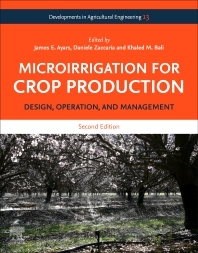
Posts Tagged: irrigation
Irrigation and Nutrient Training Workshop
|
|
|
|
|
|
|
|
|

irrigation double line citrus
Irrigation Resources
In a recent meeting the topic of where to go for irrigation information came up. Well there's no substitute for attending a class in irrigation, such as offered at Cal Poly SLO (http://www.itrc.org/classes/iseclass.htm ,
but here's some written sources to get you started thinking.
http://ciwr.ucanr.edu/california_drought_expertise/droughttips/
http://www.salinitymanagement.org/Salinity%20Management%20Guide/ei/ei_1.html
http://www.avocadosource.com/tools/IrrigationCalculator.asp
http://lawr.ucdavis.edu/cooperative-extension/irrigation/manuals
http://lawr.ucdavis.edu/cooperative-extension/irrigation/drought-tips
http://biomet.ucdavis.edu/index.php/evapotranspiration-mainmenu-32

irrigation double line citrus
Microirrigation Clogging Troubleshooting Guide
Microirrigation systems include microsprinklers for tree crops, drip emitters for trees, vines, and some row crops, and drip tape for row and field crops. Microirrigation systems apply water to the soil through emitters that are installed along drip lines and contain very small flow passages. Microirrigation systems can apply water and fertilizers more uniformly than other irrigation methods. This uniformity results in potentially higher yields, higher revenue, and reduced irrigation operating costs.
Uniformity, a performance characteristic of irrigation systems, is a measure of the evenness of the applied water throughout the irrigation system. Distribution uniformity (DU), sometimes called emission uniformity (EU), is an index that describes how evenly or uniformly water is applied throughout the field. A uniformity of 100% means the same amount of water was applied everywhere. Unfortunately, all irrigation systems apply water at a uniformity of less than 100%, and thus some parts of a field receive more water than others. Field evaluations have shown that microirrigation systems have the potential for higher uniformity than other irrigation methods. However, clogging reduces the uniformity of applied water in microirrigation systems, thus increasing the relative differences in applied water throughout a field.
The small flow passages in the emitters and microsprinklers make microirrigation systems highly susceptible to clogging. Clogging reduces the uniformity of the applied water and decreases the amount of applied water. Clogging also decreases the amount of salt leaching around the lateral line in saline soils.
The objective of this web site is to provide information to irrigators about the causes of clogging and the methods for preventing or correcting clogging problems in microirrigation systems. Among the topics covered are the sources of clogging, chlorination, preventing chemical precipitation, filtration, flushing, and monitoring microirrigation systems.
This web site is divided into sections to allow the users to more quickly access the information they want. For example, if you already know you have a clogging problem and you want to solve it, go to the section Solutions to Existing Clogging Problems - "I have a problem and I want to solve it".
https://micromaintain.ucanr.edu/

avocado irrigation 2
Calculating Irrigation with CIMIS
Avocado Irrigation Calculator using CIMIS
(California Irrigation Management Information System)
Updated March 13, 2024
Gary S. Bender
Farm Advisor Emeritus – Subtropical Horticulture
UC Cooperative Extension – San Diego County
The irrigation requirement can be calculated each week by using CIMIS (California Irrigation Management Information System). CIMIS is a network of weather stations throughout California that takes daily information on evapotranspiration (ETo) of eight-inch tall grass and sends this ETo to a computer in Sacramento. ETo is basically the amount of water lost each day from this grass; it is calculated in inches of water. You can download this information when you want to irrigate your avocados and put it into an “irrigation calculator”. This information will be multiplied by the crop coefficient developed for avocados by UC Cooperative Extension farm advisors and specialists . This will give you the amount of water lost each day by avocados through transpiration and evaporation from the soil surface. Then, assuming the weather doesn't change, you can replace that amount of water when you irrigate.
Follow the Attached Files "CMIS exercise" link below to see how it's done.
CMIS exercise

irrigation with double lines
HOW to IRRIGATE in ONE text
Microirrigation for Crop Production: Design, Operation, and Management, Second Edition is the latest release in this go-to foundational resource for the basics of engineering and the science of the design and operation of micoirrigation systems. This new edition includes novel methods for measurement and estimation of evapotranspiration, resource-efficient microirrigation design and operation, advanced irrigation scheduling methods and tools, novel methods and technology of microirrigation automation, monitoring and control, updates in crop salinity tolerance and leaching practices, variable rate irrigation, updates on the use of biological effluents and chemicals and pesticides to include safety and regulatory concerns.The revised book provides an understanding on the basic science needed to comprehend systems design, operation, management, maintenance, monitoring and performance evaluation.
Editors: James E. Ayars, Daniele Zaccaria, Khaled M. Bali

irrigATING CITRUS

